Homemade calendula salve is a beautiful thing. Make it with organic products, and from your own infused calendula oil, for a wonderful skin care product. Learn how to make calendula salve, and treat yourself and others to this nourishing herbal moisturizer made with calendula infused oil.

I was so pleased to be able to make calendula salve this season, from home-grown and dried calendula from the garden. The dried flowers were infused in an organic carrier oil, and made into a soothing salve to give as gifts to loved ones this Christmas.
Add a fragrant essential oil to give a scent to the salve. It will have a natural mild odor all on it's own, however the essential oils will make it more pleasant and aromatic to give as gifts.
The salve is so easy to make, and it sets up quite quickly.
Make sure to save some dried flowers to place on top of the mixture while it sets, to add a floral and decorative touch to the final product.

What Is Calendula Salve?
Calendula salve is a homemade skin care application and healing salve, made with calendula infused herbal oil and other moisturizing ingredients. It's great for moisturizing the skin, and for applying to minor skin irritations.
One of the most important ingredients in calendula salve is the calendula itself.
Calendula is an edible herb with bright orange and yellow flowers, easily grown from seed in the herb or flower garden. The flower is also known as pot marigold, and is a member of the Family Asteraceae.

The flowers are valued for their herbal and medicinal properties, and are often used by herbalists for treatment of different skin conditions and skin irritations.
The best species of calendula to grow for making a salve is Calendula officinalis, with it's soothing and beneficial properties. The flower heads are harvested and dried in their prime state, to use as medicinal herbs.
Calendula salve is made with dried calendula flowers, which have been infused in a carrier oil for up to two months.
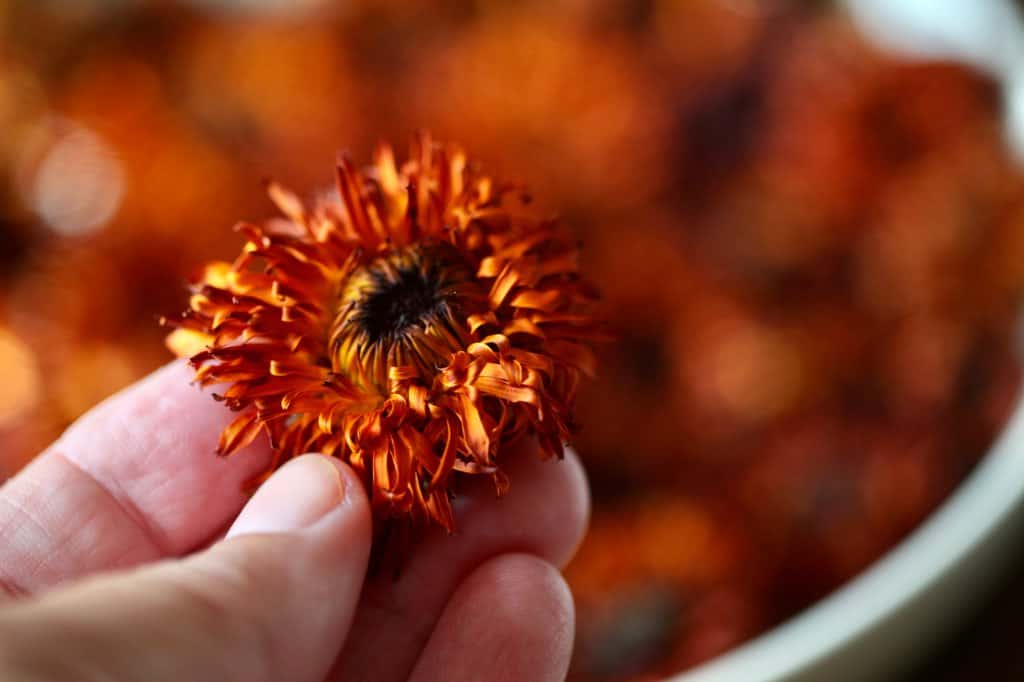
Other ingredients in the salve include beeswax and shea butter, plus essential oils for fragrance.
You can make your own calendula infused oil from your own calendula flowers, harvested and dried from your own herb garden.

What Oil Do You Use For Calendula Salve?
There are many different types of carrier oils that you can use to make a calendula infused oil, one of the major ingredients in the salve.
Before making the salve, first you must choose a carrier oil in which to infuse your calendula flowers.
Some great oils to use for making your oil infusions and salves include extra virgin olive oil, sweet almond oil, hemp seed oil, fractionated coconut oil, jojoba oil, and avocado oil.
I wrote about the different types of carrier oils to use in making calendula oil in this post: How To Make Calendula Oil.
The oil infusion process allows all the goodness and essential oils from the flowers to infuse into the carrier oil. The oil can then be used in the creation of different skin care applications.
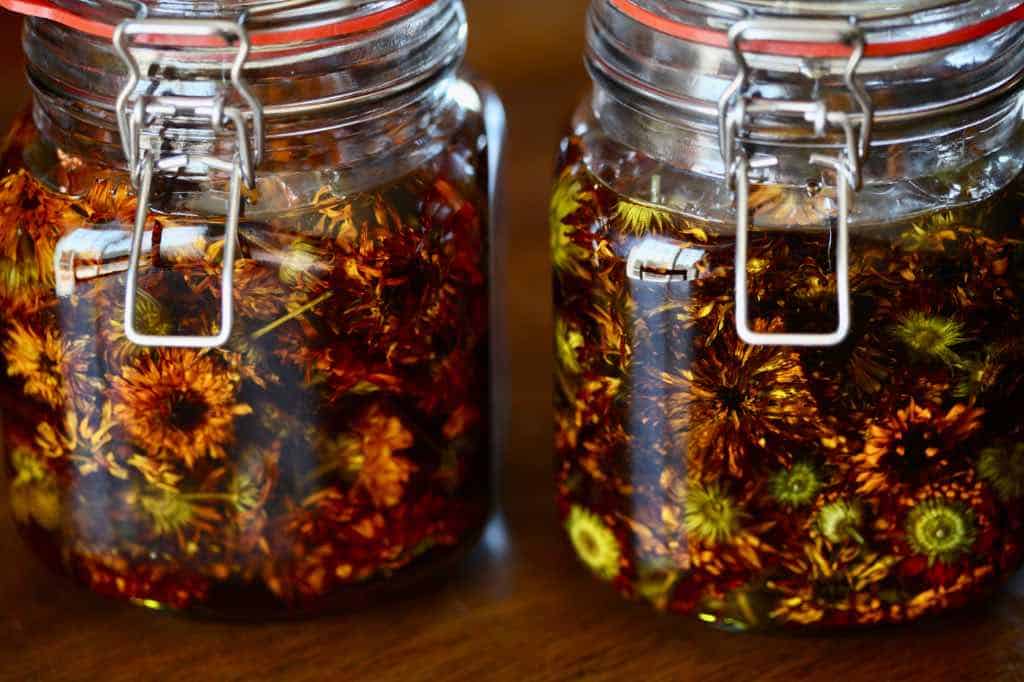
If you have used an edible oil, such as extra-virgin olive oil, the oil can be used in culinary creations as well. However, the salve itself will only be topical, and should not be ingested.
If you are making large batches of infused calendula oil, it may be best to use an edible carrier oil. That way you can use some of the extra oil for culinary purposes, as well as an ingredient for the calendula salve.
If you don't plan to used the infused oil for edible purposes, any type of carrier oil will do. However, be sure to use one that can be used topically, and organic is always best for this purpose.
If you have not had an opportunity to grow, dry, and infuse a homemade calendula oil with dried calendula flowers, all is not lost. You can also purchase a ready made calendula oil.
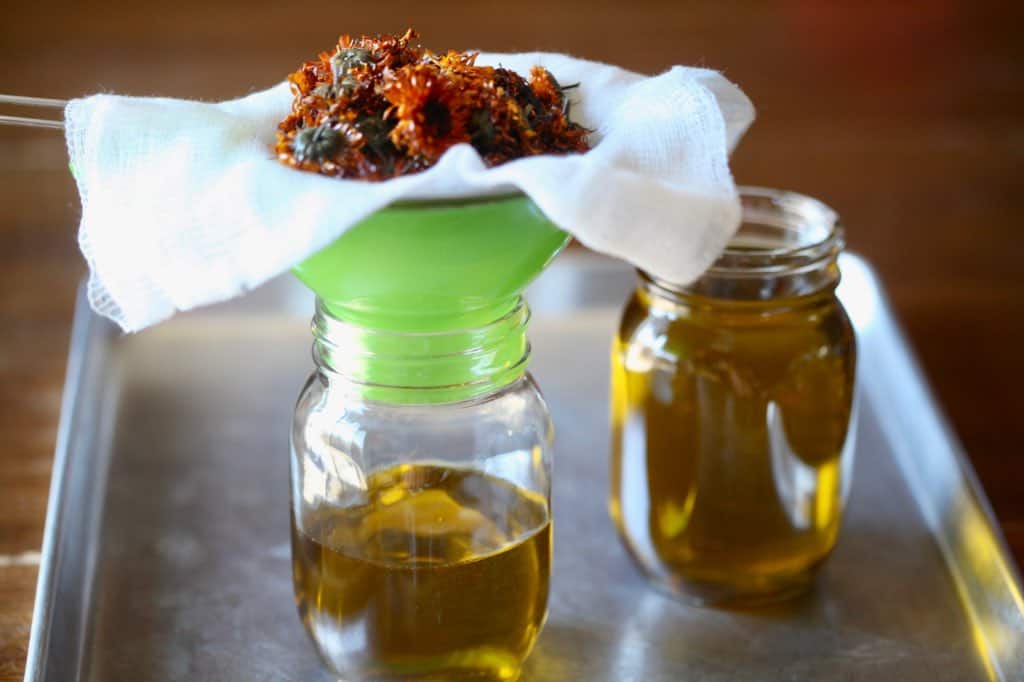
Using Beeswax To Make Salve
Beeswax is a natural product, and often organic.
Although beeswax is not a moisturizer all on it's own, when it is added together with the other ingredients in the salve, it contributes to the moisturizing effects.
Using beeswax in herbal salves helps to thicken the infused oil in the salve, giving it a more solid form for application.
The beeswax helps to firm the mixture.
It also helps to seal the moisture in, when applying the salve to the skin. This provides a protective barrier, while the salve is being absorbed, and nourishes and hydrates the skin.
Less beeswax results in a softer salve, and more beeswax results in a firmer salve. The consistency of the salve is a personal preference.
If by some chance your salve has become too thickened, the mixture can be melted down again, and more infused oil can be added, to soften the mixture.

Shea Butter Is Optional
The use of shea butter is optional, however this product will also contribute to the moisturizing effect of the final product.
Shea butter is a natural ingredient which adds an extra layer of moisture to the salve. It contains moisturizing and anti-inflammatory properties, and helps to hydrate and soften the skin.
Shea butter will also add other benefits, including vitamins, minerals, linoleic acid and antioxidants.

Adding Essential Oils
If you decide not to add any essential oils, that's okay, as the calendula oil has it's own individual earthy fragrance, and is great all on it's own.
Essential oils add additional fragrance, as well as adding the individual and unique benefits that each particular oil is known for.
You can also use fragrance oils which are not true essential oils, such as vanilla oil.
Choose oils that you love, and those with beneficial qualities, however make sure that you choose from those that will not cause a phototoxic reaction.
It's important to avoid essential oils that cause photosensitivity, which can enhance the tendency to burn skin when exposed to the sun. The labels on your essential oils should indicate whether they are sun safe or not.

Many cold pressed citrus essential oils have a tendency for this reaction.
Steam distilled oils reportedly do not cause phototoxic reactions.
Examples Of Phototoxic Essential Oils:
- Patchouli essential oil
- Mandarin leaf essential oil
- Lime essential oil
- Lemon essential oil (cold pressed)
- Grapefruit essential oil
- Angelica root essential oil
- Cumin essential oil
- Bitter orange essential oil
- Bergamot essential oil

Examples Of Non- Photosensitive Essential Oils:
- Lavender essential oil
- Lemon essential oil (steam distilled)
- German chamomile essential oil
- Jasmine essential oil
- Rose essential oil
- Eucalyptus essential oil
- Frankincense essential oil

The Benefits Of Calendula Salve
Calendula salve is a skin care product that can be used on all types of minor skin irritations. The salve is also adult and kid friendly.
The salve is made with calendula oil, which has been infused with the all of the beneficial qualities of the calendula oil, and goodness from the calendula flowers.
Calendula has long been used for it's herbal benefits, and traditionally used to treat minor skin ailments.
Calendula Salve Uses
The salve can be used on:
- dry skin and chapped skin
- minor cuts and bruises
- minor skin irritations
- insect bites
- minor burns such as sunburns
- diaper rash
The National Library Of Medicine and PubMed Central have published this article on calendula, highlighting it's wound healing properties: Wound Healing and Anti-Inflammatory Effect in Animal Models of Calendula officinalis L. Growing In Brazil.

How To Make Calendula Salve
Once you have gathered all of your ingredients together for this diy project, you may be pleasantly surprised at just how easy and simple this salve is to make.
Tools You May Need:
- a spoon
- a double boiler
- clean containers for the salve, such as metal tins or glass jars

Ingredients
These ingredients will fill three 4 oz tins, which are a great size for gift giving.
- calendula-infused oil- 1 cup
- shea butter- 1 tablespoon (optional)
- beeswax- 4 tbsp
- essential oils- 10 drops for a mild scent, 15 drops for a stronger scent
- dried petals of calendula flowers- ⅛ cup

I made two batches of calendula salve, resulting in six 4 oz tins. The great thing about making several batches of this recipe is that you can add different fragrances to each separate batch.
You can also add the essential oils to separate tins, after all of the ingredients are melted together and poured into the tins.

Directions
- Set out the containers for the salve, removing the lids.
- Set up the double boiler, filling the lower pot half full with water, and placing the smaller empty pot on top.
- Boil the water, heating up the empty pot on the top of the double boiler.
- Add the calendula infused oil, beeswax and shea butter.
- Stir together as the ingredients begin to melt.
- If you don't have a double boiler, you can also set up a makeshift double boiler by placing a heat resistant glass bowl or measuring cup into a pot of hot water. The beeswax and shea butter melt readily when warmed.
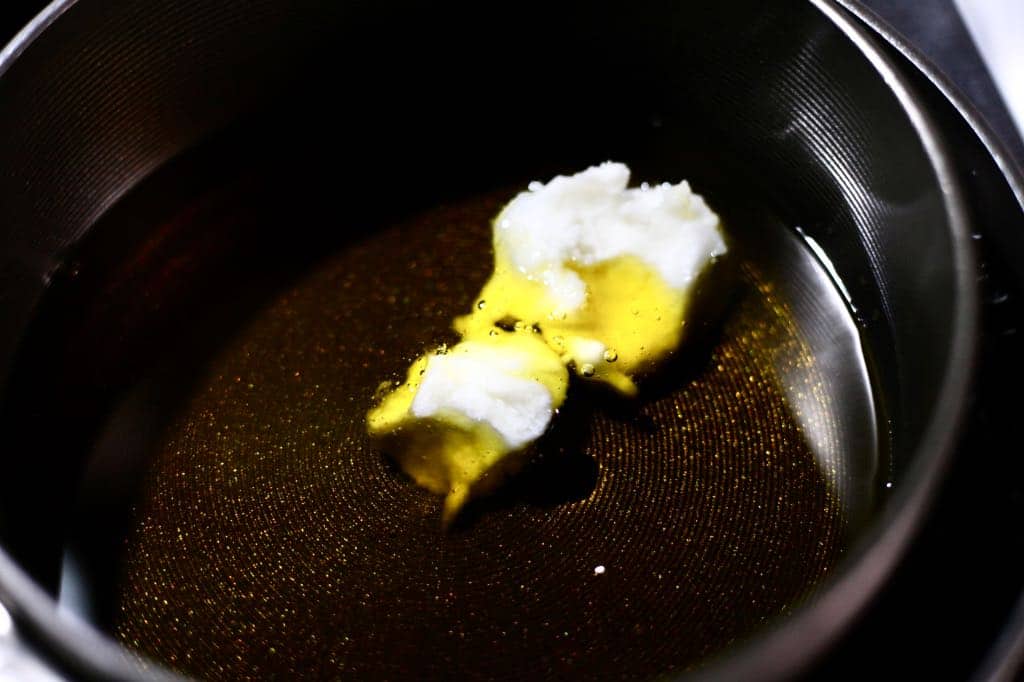

- Once melted remove the mixture from the heat.
- Add the essential oils, if you choose to do so.
- Carefully pour the mixture into the containers you have chosen for the salve.
- Do not move the containers while the salve is still liquefied.
- Be careful not to burn your fingers on the hot salve.

- Allow the salve to begin to set, then drop some dried calendula petals on top of the mixture for decoration. The petals will stick to the still moist salve, however will not sink to the bottom at this stage.
- Allow the salve to completely cool on the counter top at room temperature. It will set and become solidified as it cools.
- Once completely cool, place the caps on the filled containers.
- The salve is now ready to use, or give away as special homemade gifts.

Calendula Salve Storage
Keep the salve out of direct sunlight.
Store the calendula salve in a cool, dry and dark place.
Keep the product clean, making sure to have dry hands and clean fingers when using, to prevent cross contamination, for the best shelf life.
Shelf life is approximately one year.

Calendula Salve Recipe Card

HOW TO CARD: Calendula Salve
Homemade calendula salve is a beautiful thing. Make it with organic products, and from your own infused calendula oil, for a wonderful skin care product.
Materials
- calendula-infused oil- 1 cup
- shea butter- 1 tablespoon (optional)
- beeswax- 4 tbsp
- essential oils- 10 drops for a mild scent, 15 drops for a stronger scent
- dried petals of calendula flowers- ⅛ cup
Tools
- a spoon
- a double boiler
- containers for the salve, such as metal tins or glass jars
Instructions
- Set out the containers for the salve, removing the lids.
- Set up the double boiler, filling the lower pot half full with water, and placing the smaller empty pot on top.
- Boil the water, heating up the empty pot on the top of the double boiler.
- Add the calendula infused oil, beeswax and shea butter.
- Stir together as the ingredients begin to melt.
- If you don't have a double boiler, you can also set up a makeshift double boiler by placing a heat resistant glass bowl or measuring cup into a pot of hot water. The beeswax and shea butter melt readily when warmed.
- Once melted remove the mixture from the heat.
- Add the essential oils, if you choose to do so.
- Carefully pour the mixture into the containers you have chosen for the salve.
- Do not move the containers while the salve is still liquefied.
- Be careful not to burn your fingers on the hot salve.
- Allow the salve to begin to set, then drop some dried calendula petals on top of the mixture for decoration. The petals will stick to the still moist salve, however will not sink to the bottom at this stage.
- Allow the salve to completely cool on the counter top at room temperature. It will set and become solidified as it cools.
- Once completely cool, place the caps on the filled containers.
- The salve is now ready to use, or give away as special homemade gifts.
Notes
Store the calendula salve in a cool, dry and dark place.
Keep the product clean, making sure to have dry hands and clean fingers when using, to prevent cross contamination, for the best shelf life.
Shelf life is approximately one year.
Frequently Asked Questions:
Is Calendula Salve Good For Skin?
Calendula salve is good for the skin. It provides moisturizing and anti-inflammatory benefits.
In addition, the salve is silky and creamy, and has a softening effect.
Depending on the carrier oil used, it can be somewhat oily, however is readily absorbed into the skin.

Can I Put Calendula Salve On My Lips?
If you have used an edible carrier oil with non photosensitive essential oils, the calendula salve can be applied to the lips.
For example, if you have used an extra virgin olive oil to make the infused calendula oil, a salve made with this application will be great to use on lips.
The salve is not to be used internally, however the ingredients in the salve are the same as those used to make calendula lip balm and other lip balms made with infused oils.
Who Shouldn't Use Calendula Salve?
Calendula is an herb in the Asteraceae Family. Therefore, anyone who is allergic to plants in this family should avoid the use of calendula products.
Pregnant or breastfeeding women should also avoid use of calendula, due to estrogenic effects.
Please note, before using any herbal treatments on medical conditions, it’s always best to discuss your condition and intended treatment with your family physician.

Conclusion
Making your own salve from your own homegrown calendula flowers is so much fun.
Made with herbal-infused oils and natural moisturizers, this salve is a great skin care product with medicinal uses, to have on hand for minor skin irritations and dry skin.
The golden color of the cooled salve is beautiful, and natural looking, especially if you have used dried calendula petals to decorate the mixture while setting.
Make some salve for your own family, and also some extras to give away as gifts. It's a great way to share these special herbs from your garden.
I will be planting more calendula flower seeds next year, harvested from this year's garden, and making more of this wonderful salve again next year, to use and to share.

Other Posts You May Like:
PIN IT FOR LATER!








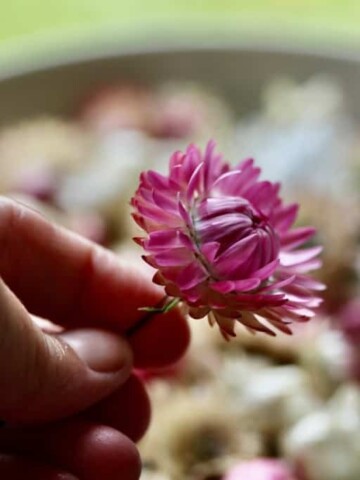

Suzanne
This looks so good! What a great natural remedy to have on hand!
Cheyanne Mullin
Thanks so much Suzanne! Yes this is a wonderful homemade salve, especially if you can make it with flowers from your own garden.
Vanessa
Thanks for sharing! Does it keep long?
Cheyanne Mullin
Hi Vanessa, thanks for the comment! Shelf life is approximately 1 year with proper storage.